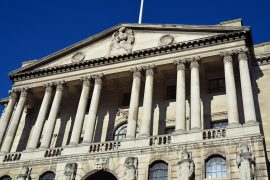Bank of England adds another £100bn to combat COVID-19 economic crisis
The Bank of England (BoE) on 18 June added another £100 billion to its quantitative easing (QE) program in a bid to shore up the UK economy amid the fallout from the coronavirus (COVID-19) crisis.
The additional bond purchases will take the total value of the central bank’s Asset Purchase Facility (APF) to £745 billion.
The BoE’s latest monetary policy decision comes as the UK economy attempts to recover from an unprecedented 25% contraction across March and April as lockdowns forced by the pandemic hammered economic activity.
Sterling sank against the dollar and euro on Thursday, falling more than 1% following the announcement. Prior to the decision, sterling was trading as much as 0.5% lower against both the dollar and the euro.
In its May Monetary Policy Report (MPR), the Bank forecast the country’s worst economic decline since 1706, but in a press call following the decision, BoE governor, Andrew Bailey, said recent data had indicated that the peak of the downturn “probably wasn’t as severe” as the illustrative scenario outlined in the MPR.

Sterling sank against the dollar and euro on Thursday, falling more than 1% following the announcement.
Bailey says the slowing of asset purchases was based on a calming of financial markets and economic conditions in March but did not mean the central bank was taking its foot off the gas.
“We’re slowing from warp speed to something that by any historical standards still looks fast,” Bailey tells reporters.
“The committee spent a lot of time on this and they thought it was justified, but there are two things — one is the news as to how the economy was developing and how it looked relative to our expectations back in May particularly, and even going back to March.”
The second, he explained, was the stabilisation of financial markets, but he stressed that the Bank will “maintain flexibility” as it pursues a slower pace of bond buying.
Read more: Monzo co-founder joins new UK challenger bank GBB as non-exec chair
According to CNBC, the Bank resisted taking interest rates into negative territory, a decision being closely watched by investors, instead opting to hold its main lending rate steady at 0.1%. Rates have been reduced twice from 0.75% since the beginning of the COVID-19 pandemic.
“Despite its recent flirting with negative policy rates, we think it is quite unlikely the Bank will go down this path,” says Luke Bartholomew, investment strategist at Aberdeen Standard Investments.
“Instead we expect further QE to be announced in time, along with tweaks to its credit provision facilities, making it easier and cheaper for banks to finance lending to the real economy.”
Economists had broadly expected the central bank to expand its bond-buying program. ING Developed Markets economist, James Smith, pointed out earlier this week that the size of asset purchases sits at £598 billion at the last count, indicating that the original £645 billion target set in March could be exhausted by July.
Smith suggested that an extra £100 billion would allow the BoE to continue purchases until early September, which would mean another top up again in August.
The UK remains the fifth worst affected country in the world by the pandemic, with more than 300,700 confirmed cases and more than 42,200 deaths as of Thursday morning, according to Johns Hopkins University.
Check out the COVID-19 hub for more on how the industry is responding to the pandemic











































